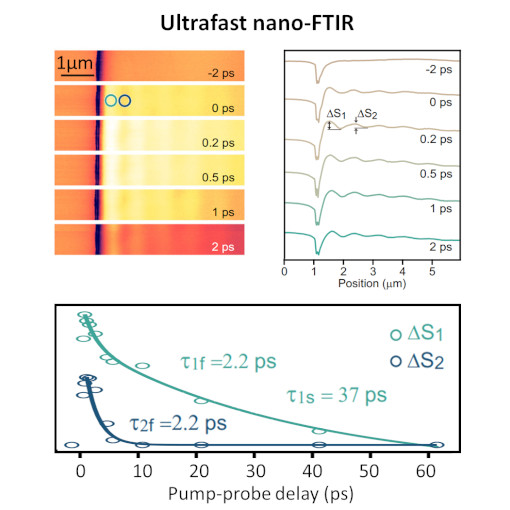
Plasmons Revolutionize Optoelectronics
In recent developments, researchers from multiple prestigious institutions across China have significantly advanced optoelectronics by harnessing the properties of hyperbolic transient plasmons in black phosphorus (BP), a material known for its unique anisotropic electronic and optical characteristics. This advancement comes from the ability to manipulate BP's charge carriers, enabling hyperbolic plasmon polaritons and overcoming previous challenges associated with hyperbolic polariton materials. The breakthrough involved a topological transition in BP's dielectric tensors through photo-induced carrier injection, making it possible to transform its iso-frequency contour and unlock the potential of rare transient hyperbolic plasmons. These plasmons exhibit ultrafast transitions, minimal propagation losses, and efficient optical emissions.The ultrafast nano-FTIR nanoscopy technique has been pivotal in revealing transient plasmonic phenomena at the nanoscale, driving innovations in optoelectronics, photonic circuits, sensors, and energy systems through the dynamic modulation of BP's properties.
This measurement was realized with the IR-neaSCOPE+fs.
Further reading:
Fu et al., Nature Communications 15, 709 (2024)
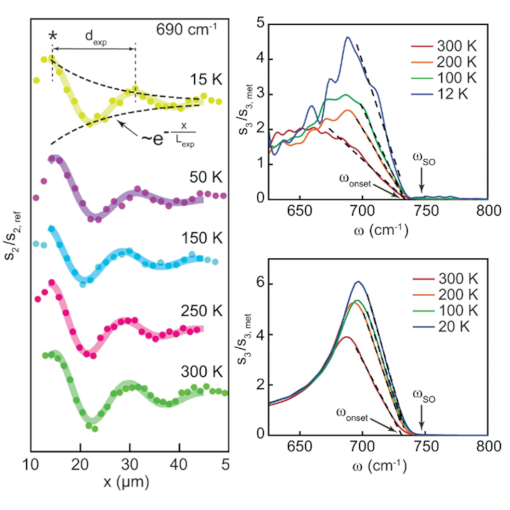
cryo-Tuning Surface Phonon-Polaritons
This research explores how adjusting the temperature and electrical properties affects surface phonon-polaritons in LaAlO3/SrTiO3 heterostructures, a promising area in nanophotonics. A significant contribution to this study is the use of nano-FTIR and s-SNOM techniques. Nano-FTIR allowed for detailed spectroscopic analysis at the nanoscale, enhancing the understanding of surface phonon-polaritons in these materials. The s-SNOM technique was pivotal in imaging and probing the properties of phonon-polaritons, providing crucial insights into their behavior under varying thermal and electrostatic conditions. This research underscores the potential of LaAlO3/SrTiO3 heterostructures in nanophotonic applications, bridging the gap between unconventional electronics and long-wavelength nanophotonics. The findings demonstrate the tunability of phonon-polariton properties, paving the way for advancements in infrared technology and material science.
This measurement was realized with the cryo-neaSCOPE+xs.
Further reading:
Zhou et al., Nature Communications 14, 7686 (2023)
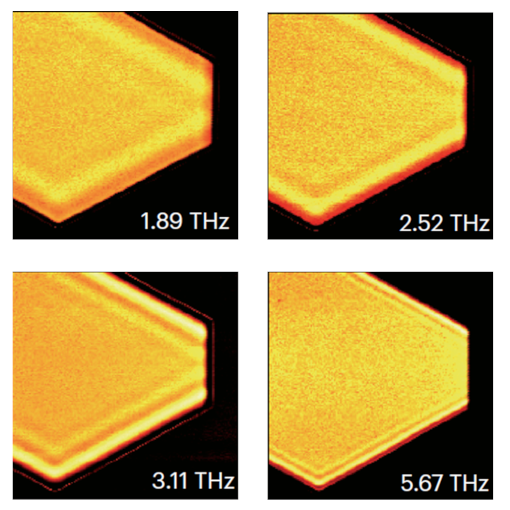
THz Plasmon Polaritons
Plasmon polaritons are quasiparticles resulting from the coupling of surface plasmons with light. Such Polaritons possess tremendous potential for investigating essential material properties and advancing the field of nanophotonics by enabling the creation of innovative devices. However, the direct observation of ultraconfined in-plane anisotropic plasmon polaritons has proven to be a scientific and technological challenge until now. With this publication, the authors used s-SNOM to image ultraconfined in-plane anisotropic THz plasmon polaritons in a narrow-bandgap semiconductor with strong anisotropy. By placing the platelets above a gold layer, the hybridization of plasmon polaritons with their mirror image enhances the direction-dependent propagation length and confinement of the polaritons. The THz s-SNOM images of the Ag2Te/SiO2/Au heterostructure reveal up to three narrow polariton fringes parallel to the edges. These findings expand the control and manipulation of polaritons, offering potential for nanoscale photonic devices and applications.
The study demonstrates the use of THz plasmon polaritons for measuring anisotropic charge carrier masses and damping.
This measurement was realized with the THz-neaSCOPE+s.
Further reading:
Chen et al., Nature Materials 84, 2869 (2023)
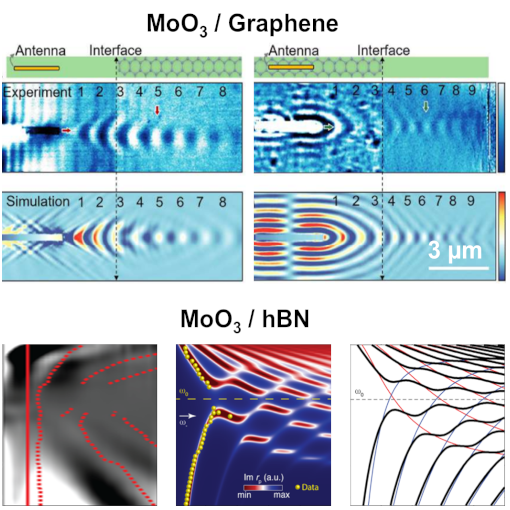
Nanoscale Negative Refraction
Refraction is a familiar effect in which a light beam alters direction as it propagates from one medium to another. Negative refraction is a nonintuitive but well-established effect in which the light beam is bent in the “wrong” direction. Two groups now independently demonstrate negative refraction at the interface of two-dimensional van der Waal materials. Hu et al. used molybdenum trioxide with a graphene MoO3 / Graphene overlayer to show that in-plane negative refraction of mid-infrared (mid-IR) polaritons occurs at the interface and is gate tunable. Sternbach et al. used molybdenum trioxide/hexagonal boron nitride MoO3 / hBN bicrystals to show that negative refraction of mid-IR polaritons occurs for propagation normal to the interface.
Polaritonic negative refraction in the mid-IR provides opportunities for optical and thermal applications such as IR super-resolution imaging, nanoscale thermal manipulation, and chemical sensing devices with enhanced sensitivity.
This measurement was realized with the IR-neaSCOPE+s.
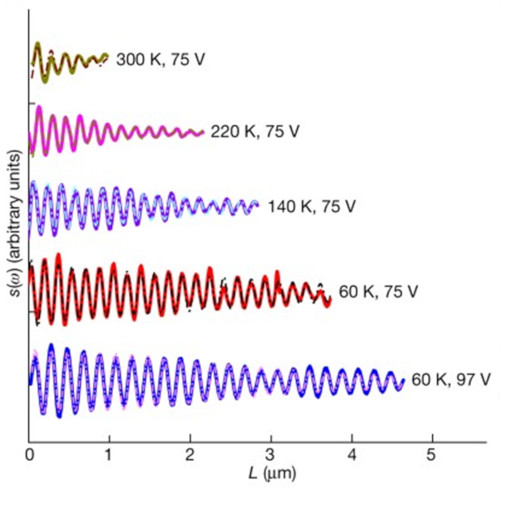
Cryogenic boost to graphene plasmonics
Scientists use graphene plasmon polaritons to squeeze the energy of long-wavelength radiation at the nanoscale and access several quantum effects with wide application range from fundamental research to industry (e.g. lasing, topological protection or dipole-forbidden absorption). The common tool for investigating and optimizing such processes is s-SNOM, however room temperature studies on this sample-system show strong plasmonic dissipation and prevents us to achieve highly confined modes of long plasmonic lifetimes. This study uses s-SNOM at cryogenic temperatures to bypass those shortcomings and to unravel the fundamental limits of propagating plasmon polaritons in high-mobility encapsulated graphene. Already at 60 °K, the propagation length can exceed 50 plasmonic wavelengths, thus setting a record for highly confined and tunable polariton modes. In this regime, the propagation of plasmon polaritons is primarily restricted by the dielectric losses of the encapsulated layers, with a minor contribution from electron–phonon interactions.
Cryogenic s-SNOM controls the losses in heterostructure engineering applications.
This measurement was realized with the cryo-neaSCOPE+xs.
Further reading:
Ni et al., Nature 557, 530-533 (2018)
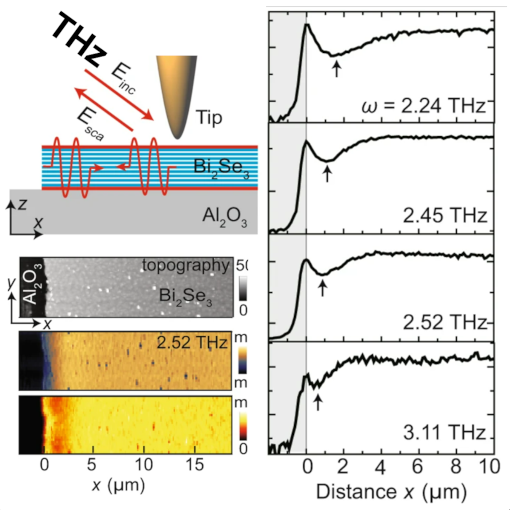
THz Polaritons Nanoimaging
Plasmon polaritons in metals, doped semiconductors and 2D materials have wide application potential for field-enhanced spectroscopies, sensing, imaging, and photodetection. Although polaritons have been observed by many IR s-SNOM studies, real-space imaging of propagating THz polaritons has been missing so far. This study brings the analytical power of s-SNOM to the THz spectral region. In this study, spectroscopic THz near-field images reveal polaritons with up to 12 times increased momenta as compared to photons of the same energy. From the images the authors determine and analyze the polariton dispersion, showing that the polaritons can be explained by the coupling of THz radiation to various combinations of Dirac and massive surface carriers, massive bulk carriers and optical phonons.
THz s-SNOM provides critical insights into the nature of THz polaritons in topological insulators and establishes instrumentation and methodology for imaging of THz polaritons.
This measurement was realized with the THz-neaSCOPE+s.
Further reading:
Chen et al., Nature Communications 13, 1374 (2022)
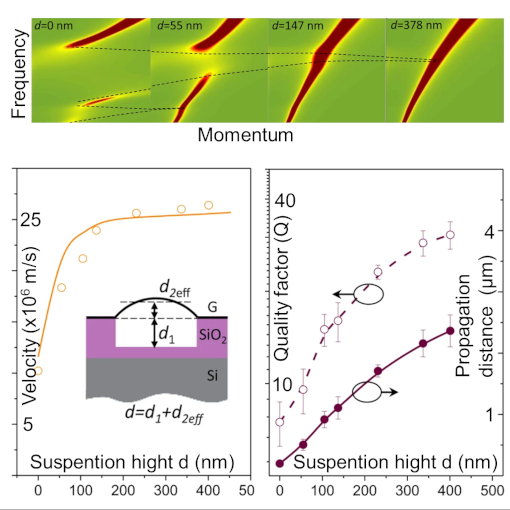
Plasmon in Suspended Graphene
Plasmons in 2D graphene have been invariably studied in supported samples so far. The substrate provides stability for graphene but often causes undesired interactions (such as dielectric losses, phonon hybridization, and impurity scattering) that compromise the quality and limit the intrinsic flexibility of graphene plasmons. This s-SNOM study demonstrate the visualization of plasmons in suspended graphene and introduces the graphene suspension height as an effective plasmonic tuning knob that enables in situ change of the dielectric environment and substantially modulates the plasmon wavelength, propagation length, and group velocity. Such active control of micrometer plasmon propagation facilitates near-unity-order modulation of nanoscale energy flow that serves as a plasmonic switch with an on-off ratio above 14.
The suspended graphene plasmons possess long propagation length, high tunability, and controllable energy transmission simultaneously, opening up broad horizons for application in nano-photonic devices.
This measurement was realized with the IR-neaSCOPE+s.
Further reading:
Hu et al., Nature Communications 13, 1465 (2022)
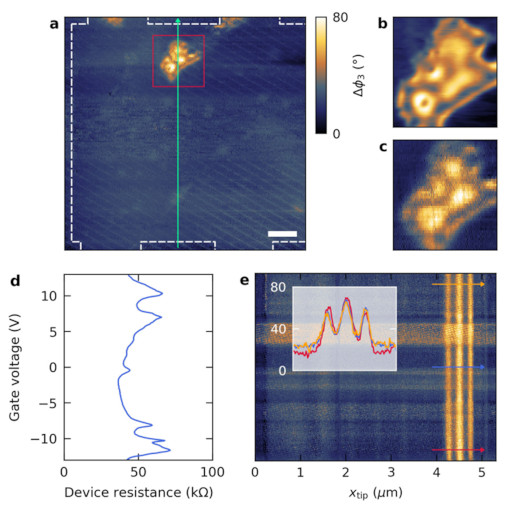
Excitations in Twisted Bilayer Graphene
Twisted bilayer graphene (TBG) can exhibit vastly different properties than those of single layers of graphene, especially when the two layers are rotated relative to each other by a small angle of approximately 1 degree. Investigating and probing these properties could be highly valuable, as it could ultimately enhance the current understanding of superconductivity and facilitate its use for the development of new devices. In this study s-SNOM investigation of TBG allows the spatial probing of interaction effects at the nanoscale and potentially elucidates the contribution of collective excitations to many-body ground states.
"As twisted graphene structures form a class of materials hosting many fascinating phenomena, we basically just have started the journey," says Prof. Koppens, the leader of the study. "We now aim to access the correlated states at cryogenic temperatures.
cryo s-SNOM technology sensitivity to the electronic properties of TBG could potentially point at the physical mechanisms of the superconducting and magnetic phenomena.
This measurement was realized with the cryo-neaSCOPE+xs.
Further reading:
News PHYS.ORG
Hesp et al., Nature Physics 17, 1162–1168 (2021)


